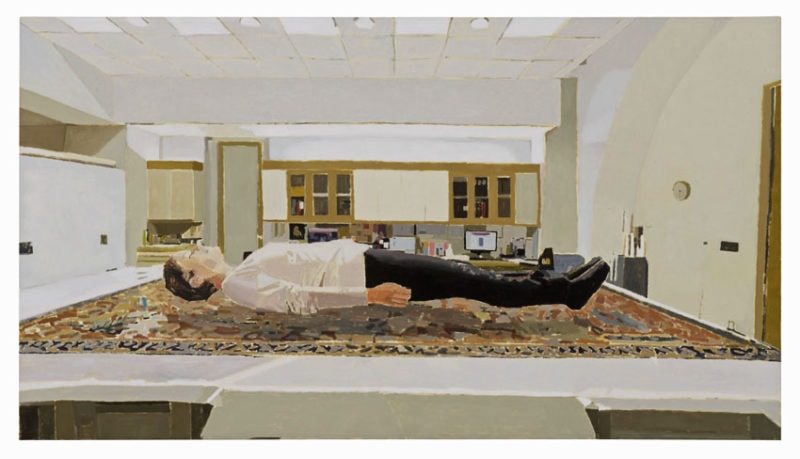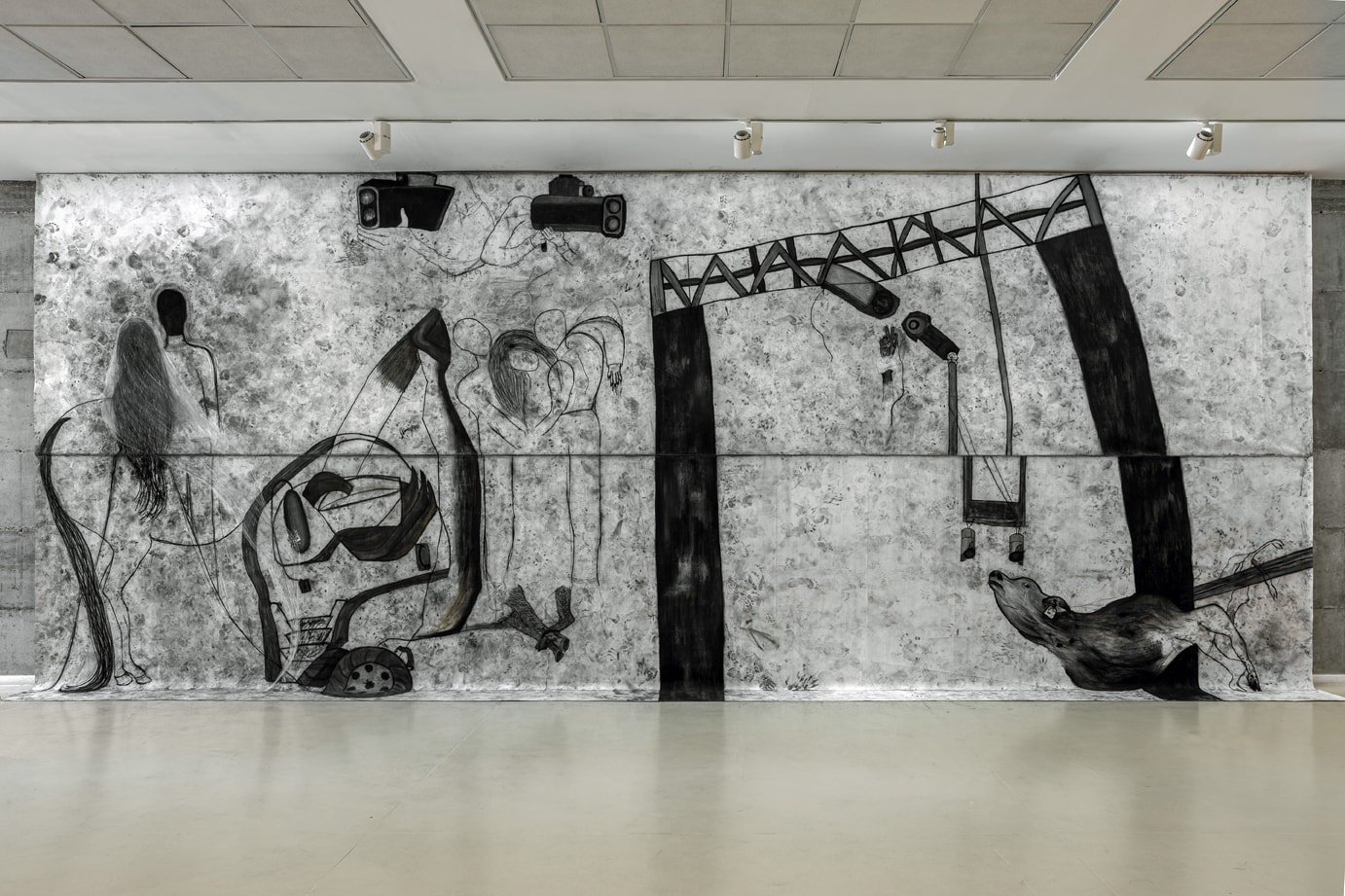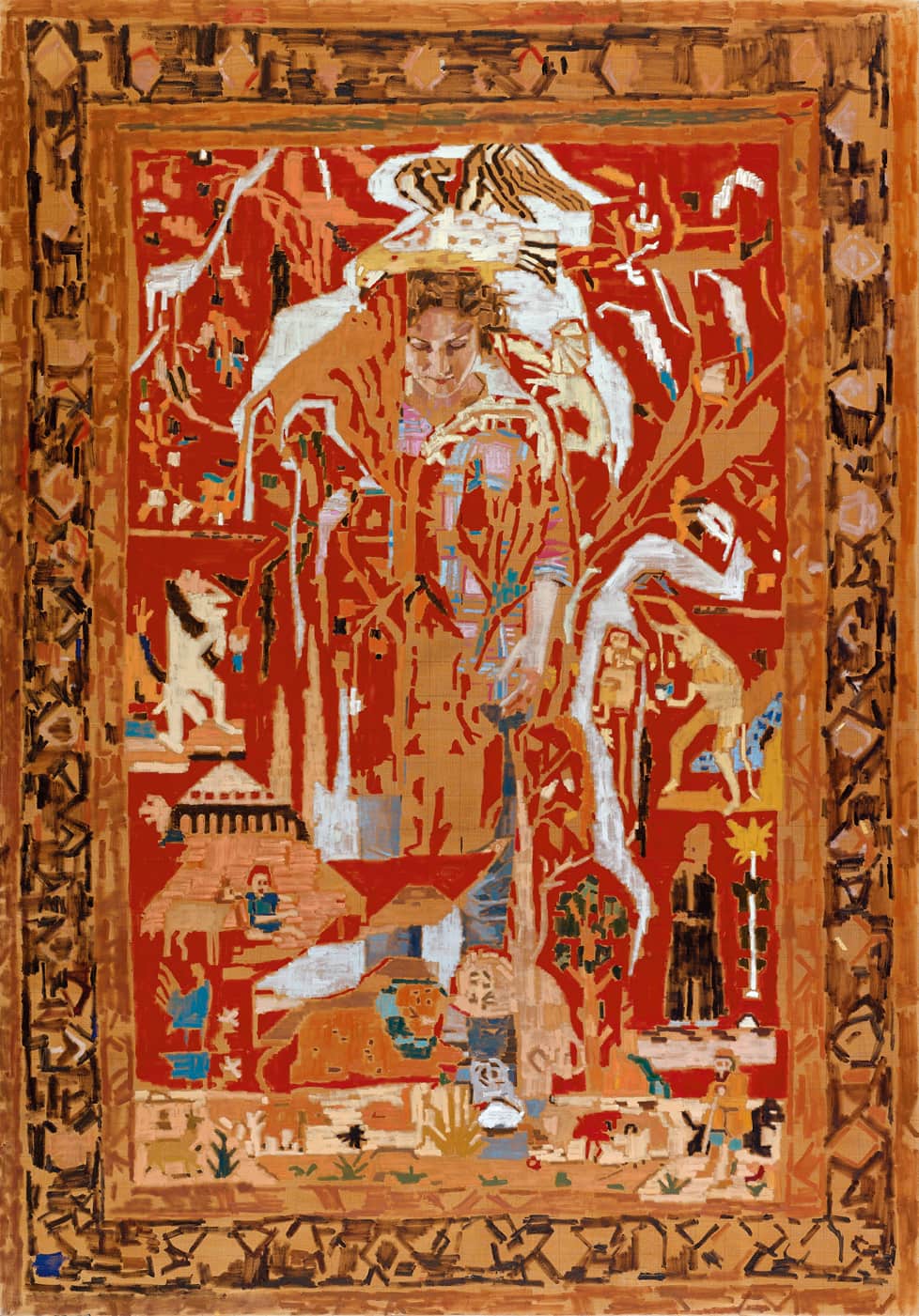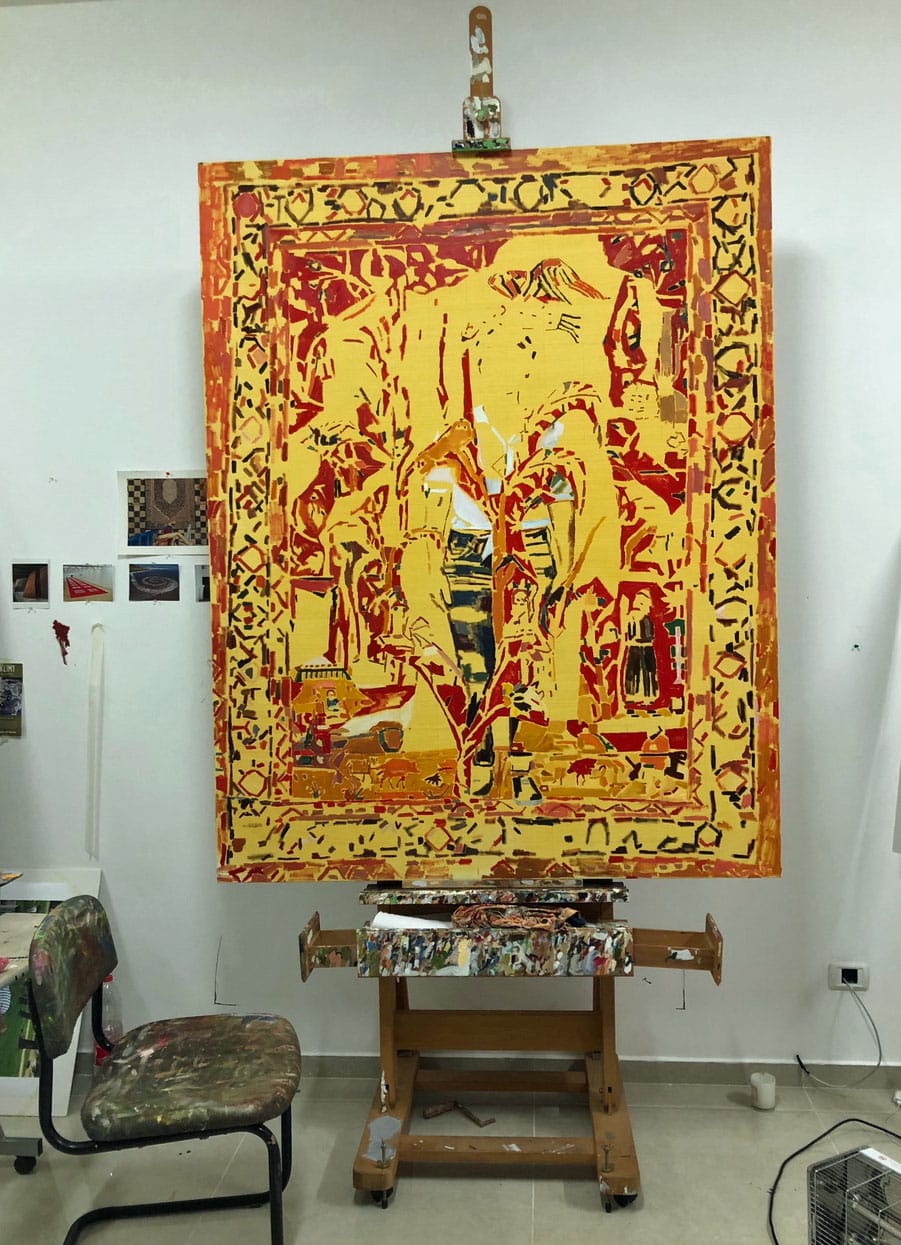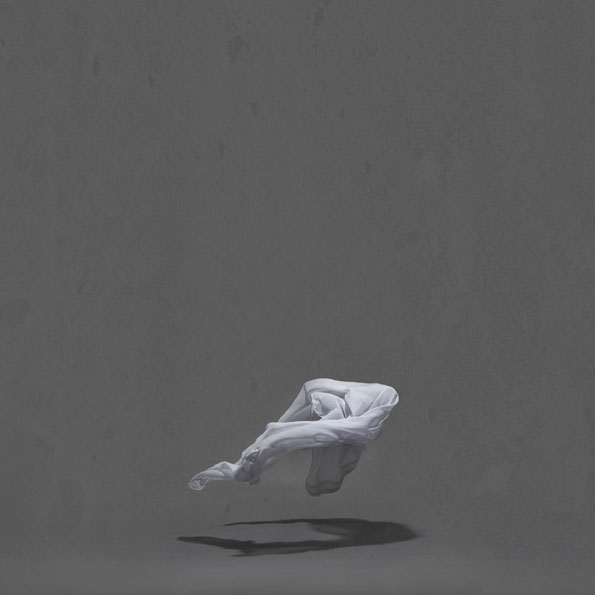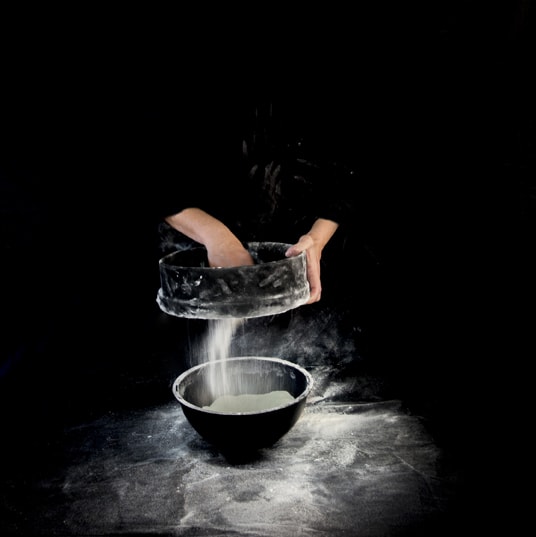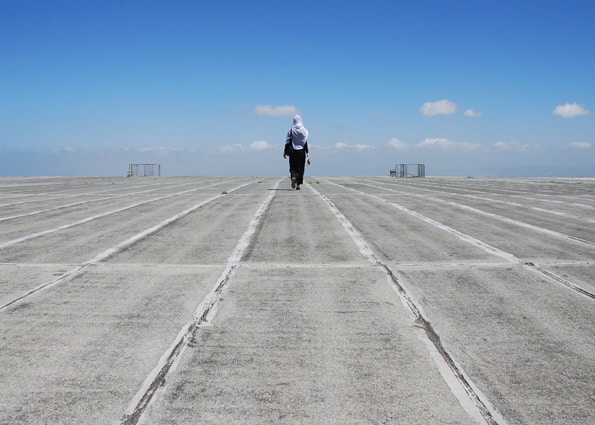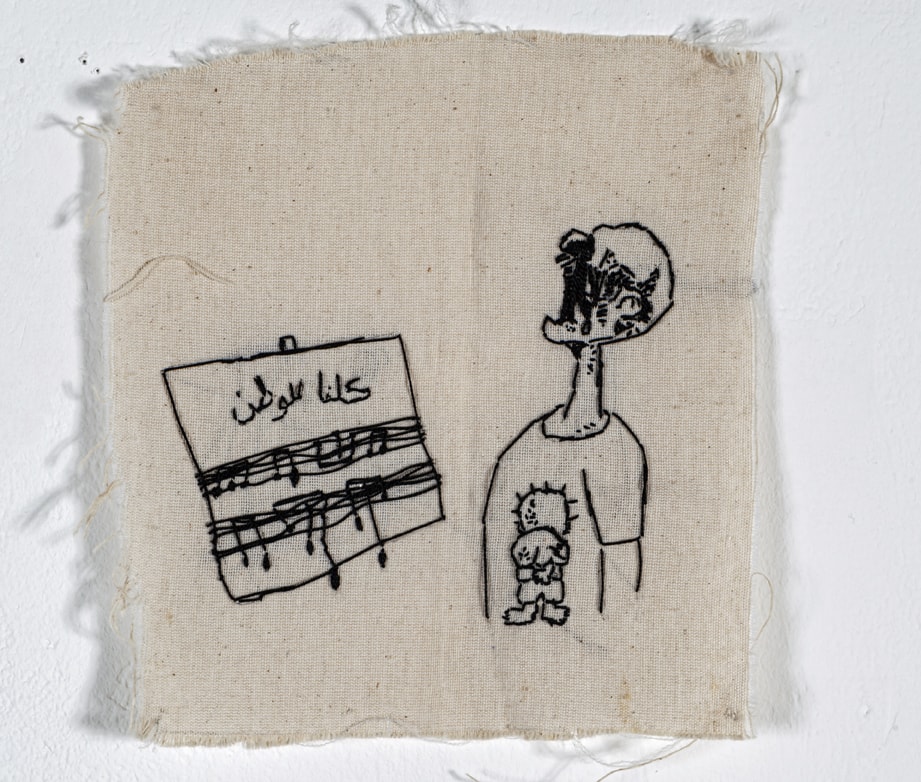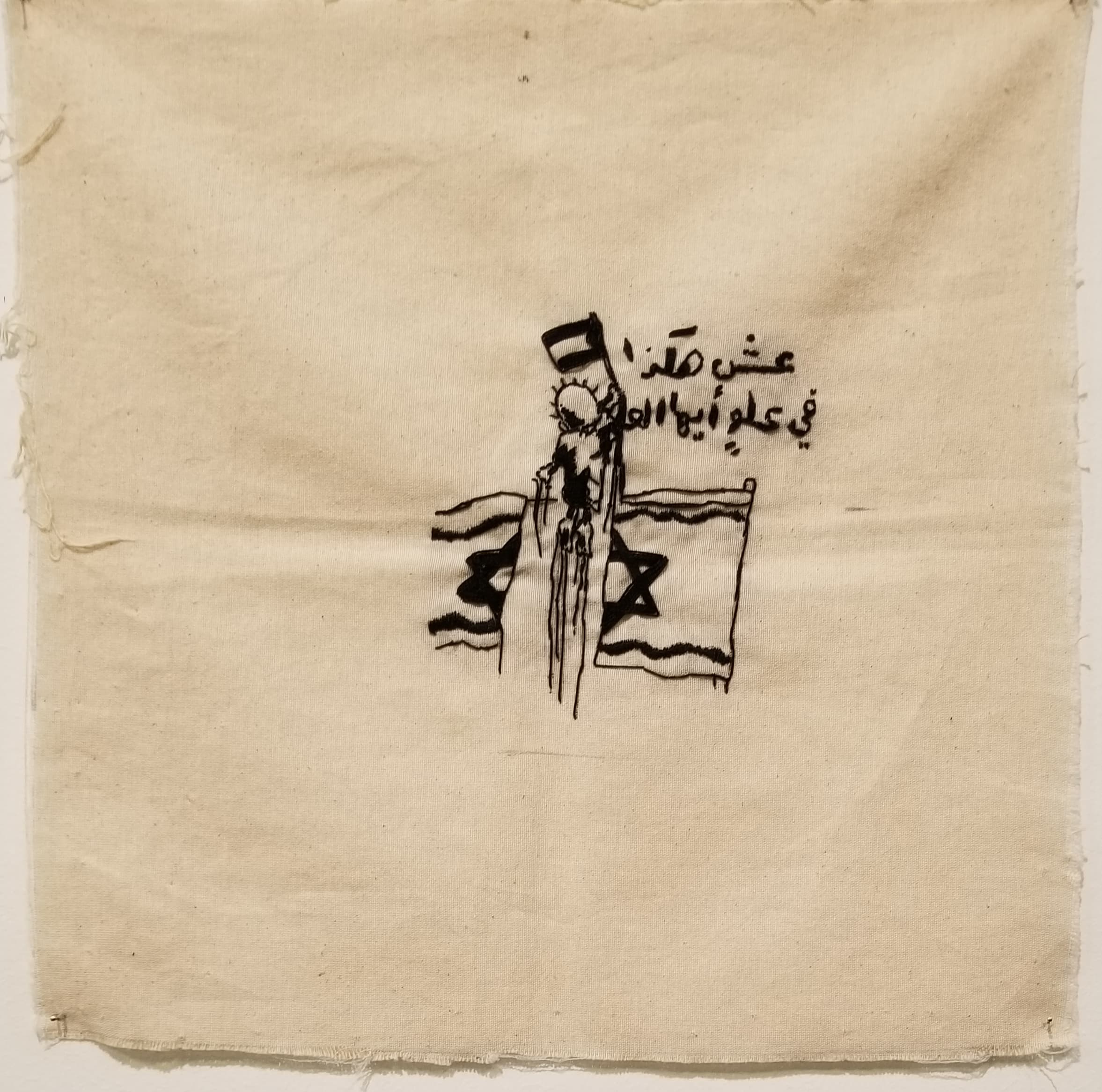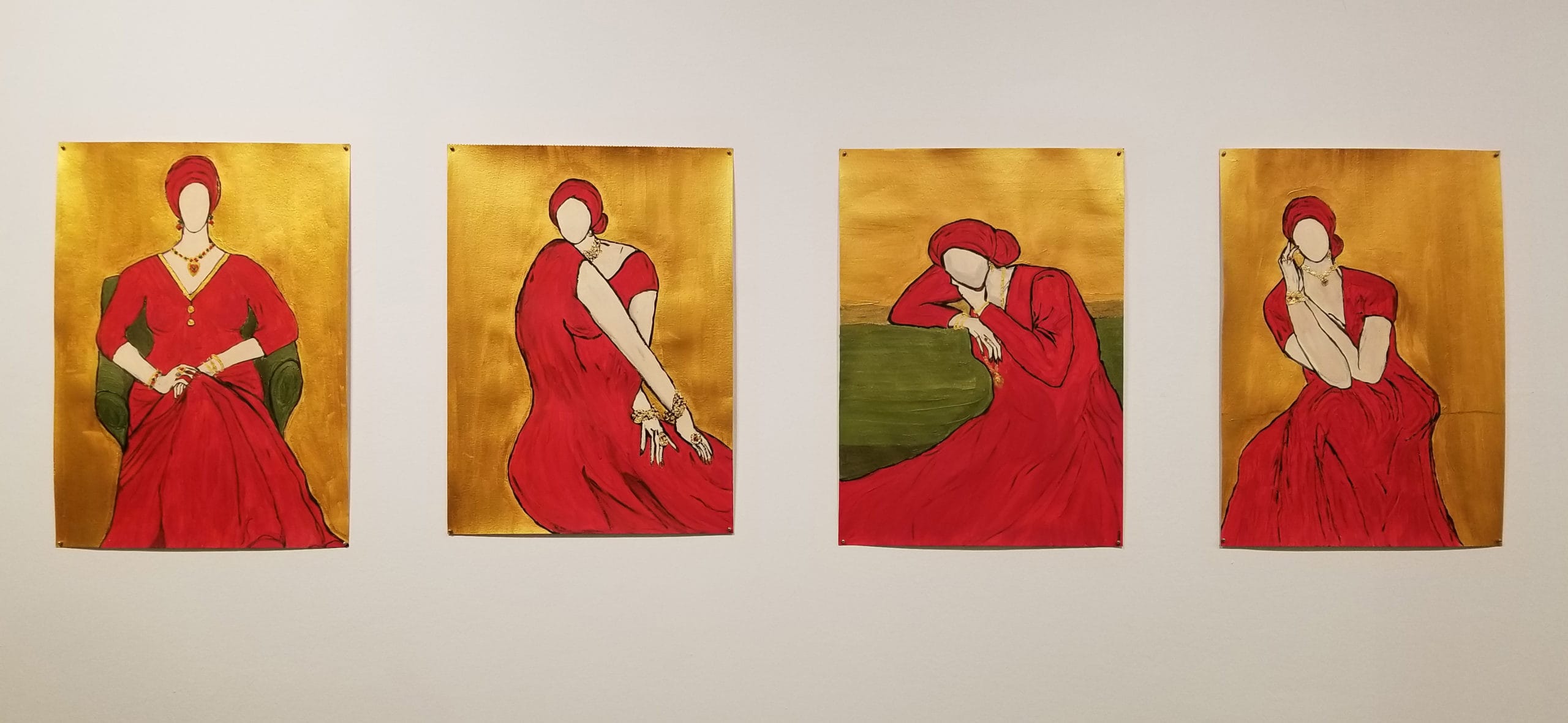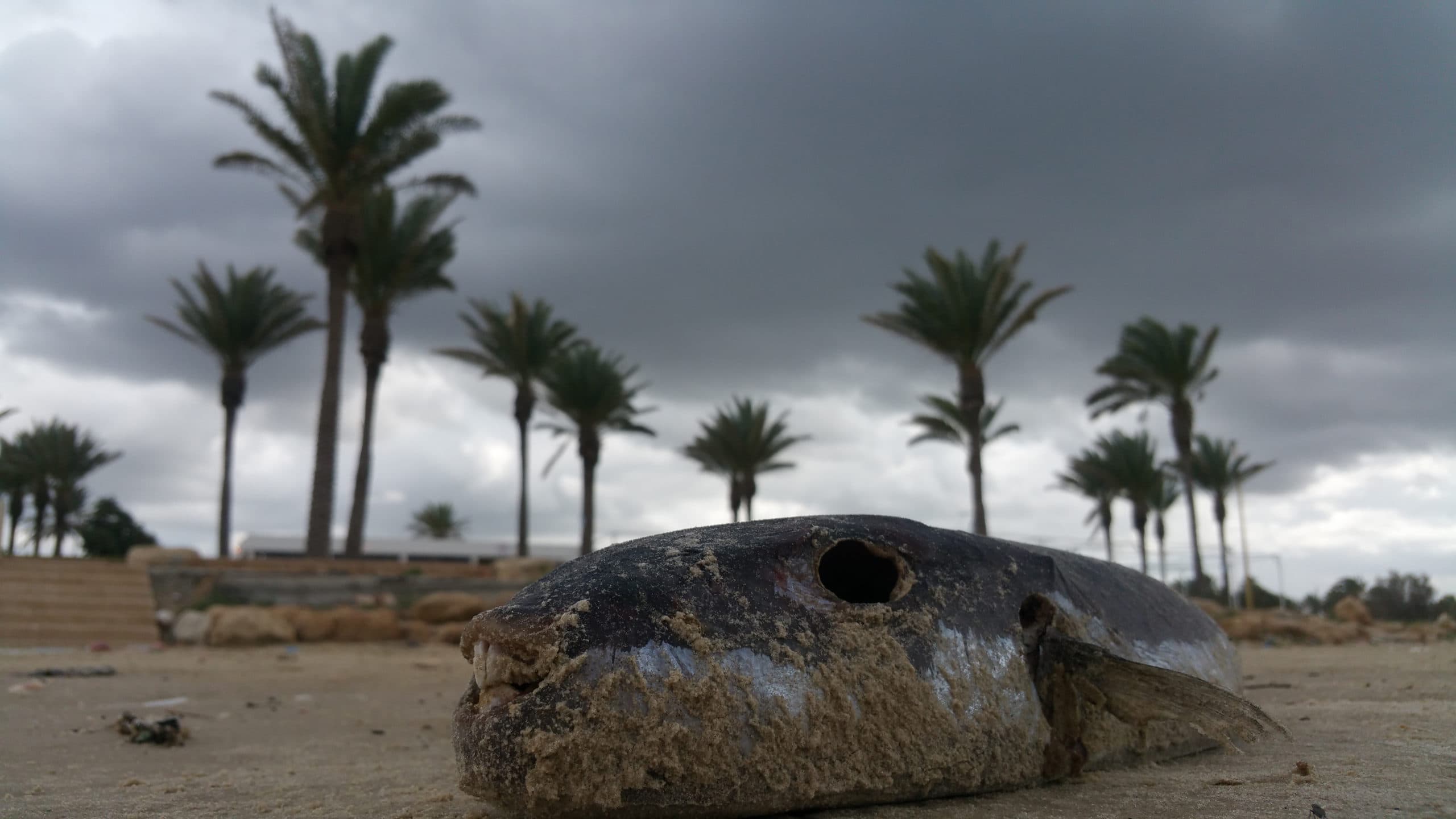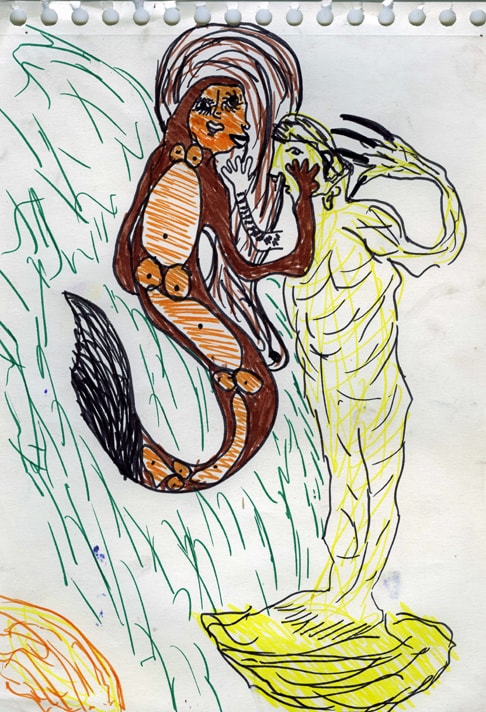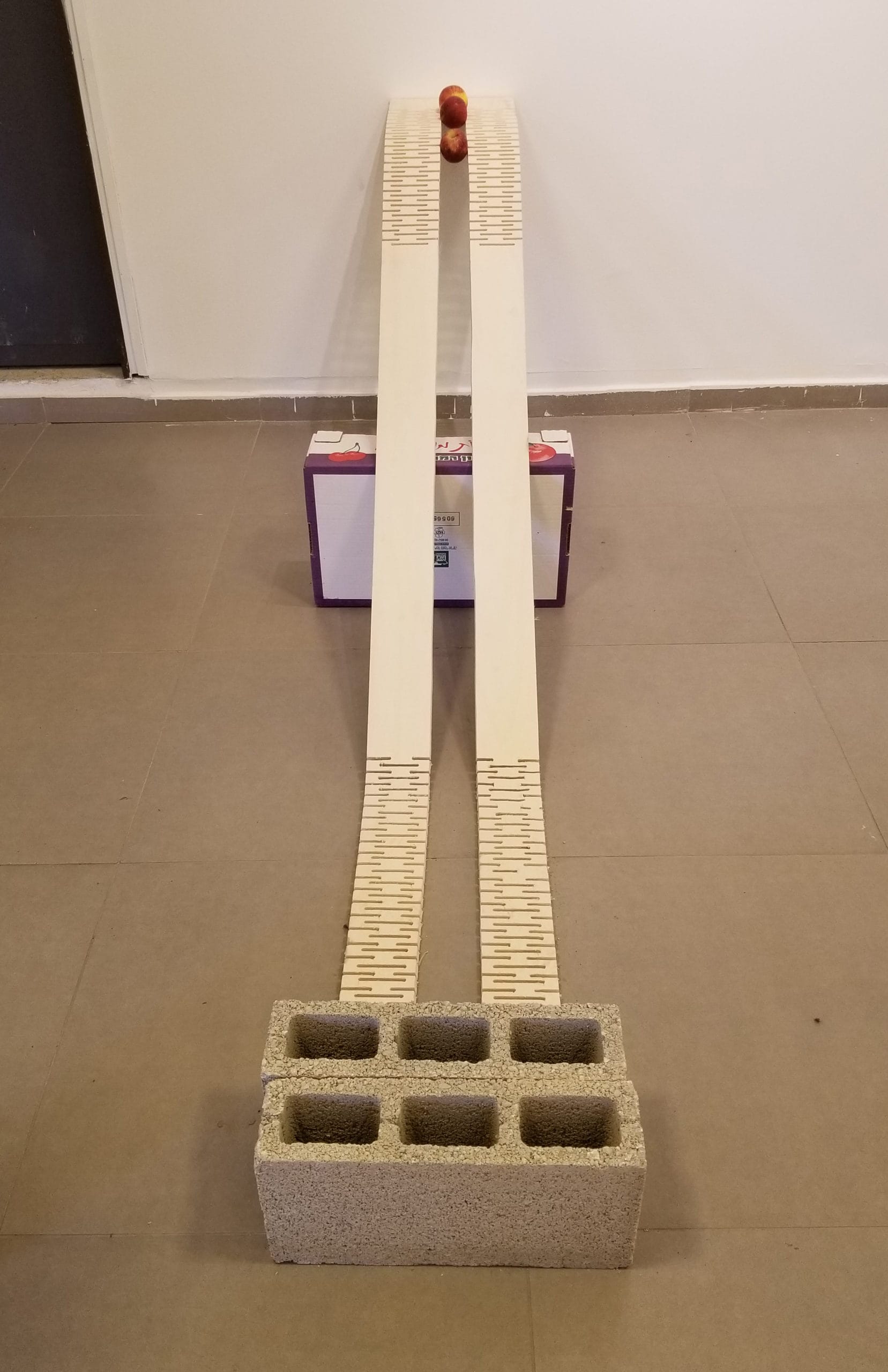The plan was to meet Maria Saleh Mahameed at noon at the Herzliya Museum, north of Tel Aviv. She was giving a gallery talk in Hebrew on her mural Ana Hoon (“I Am Here” in Arabic), which was installed on a large wall at the entrance of the museum, in conjunction with a gallery talk by Aya Lurie, Director and Chief Curator. The mural, whose figures seem to float above the surface like an ancient cave drawing or certain of Chagall’s paintings, tells the story of her nearly fatal accident, when her car was hit by a truck filled with calves bound for the slaughterhouse.
Highway 6, where the accident took place, is a major electronic toll highway that uses a system of cameras and transponders to toll vehicles automatically. It runs from north to south for 204 kilometers. I squinted hard at the title of the artwork, Ana Hoon, struck by how closely the English transliteration of the Arabic words was to those of the Hebrew words for “I am here”: Ani Henah.
Drawn in charcoal while crouched on the floor of her parents’ living room, the pieces of canvas, subsequently joined together, remain covered with handprints and footprints, dog and cats prints, smudges which were intentionally not erased. They are part of the work, Saleh Mahameed explained, there to convey the sense of “walking all over the piece.” It is a bold statement from an artist who could not move for several months following her accident.
Originally intending to be a graphic designer, Saleh Mahameed shifted course when people told her that she had a good artist’s hand. “At first, I was upset,” she confessed, before realizing “that I would be more free and more able to express myself with art.” It was a bold decision. Until recently, even in most educated Palestinian homes, children, and especially daughters, were not encouraged to go on to higher education in the arts or to pursue careers as artists. “Part of the reason for this bias,” says Nurit Shamir, the project director of the Umm el-Fahem Art Gallery, “is that after the 1948 war the local community, with its rural heritage of crafts was destroyed. When the Arab community entered into survival mode,” she said, “every Arab mother was like a Yiddishe mother. She sent her kids to be professionals. There was a huge vacuum in the arts.”
Today, Maria Saleh Mahameed and many other gifted Palestinian and Druze women artists—among them Fatma Shanan, Amira Ziyan, Ala Haytham, Hanin Hassadiye, Soha Faroja, Aysha Arar, and Lobna Awidat—are succeeding in filling this void. Building on tradition while breaking out from traditional modes, they are leaving their mark on the Israeli and global art scenes.
Dressed entirely in black with stylish knee-high suede boots, Saleh Mahameed wears a bright, flowered shawl draped around her shoulders. It is the only hint of her unusual heritage, Ukrainian on her mother’s side and Palestinian on her father’s. Her parents met when her father was studying law in Kiev. “I do all the traditions,” she said. “I am an insider here and there and I am not there and not here.” Then, after a pause, she added for emphasis: “I will always be both. I will never be shalem, complete.”
Saleh Mahameed insists that her style is not Palestinian. “I painted this piece from a few different perspectives,” she said. Pointing to the black frame on the right of her canvas with its surveillance cameras, she added: “One perspective is from the No. 6 Road, which, in places, is close to the wall separating Israelis and Palestinians. Another is from the toll road where you pay money, and a third is from the accident itself, from my injuries and the death of the calves.”
In the mural, cameras dangle ominously from the overhead frame, partially collapsed on the body of a calf, his ear marked with a Number 6 tag. There are red smudges encircling his eye and blood oozes from his mouth. Blood drips from Saleh Mahameed’s injured legs which are clearly broken and crossed at odd angles, while two men hold her upright. Over her broken body, her mane of hair falls full and defiant. On the left side of the mural, we see the happy ending, with Maria Saleh Mahameed and her fiancée Rami Habib-Allah at their recent wedding. Here, her long hair hangs protectively over them both—an omen for a bright future.
From Herzliya, I headed north to the Druze village of Julis, its Arabic-speaking population just under 7,000, to visit the studio of Fatma Shanan, a 34-year old artist, whose painting Self-Portrait and a Carpet 2 (2017) sold last year at Sotheby’s for $35,000. I first saw Shanan’s work in April 2017 in an Artport group show in Tel Aviv. It was breathtaking; her bright palette and intricate brush strokes transforming oriental carpets, a staple in every Druze home, into impressionistic landscapes that were complex and delicate, traditional yet radical. In the beginning, Shanan would stage scenes in Julis and then photograph them, using the photographs as a source for her paintings. By exporting the rugs into new surroundings and by weaving her own body and those of female relatives into the design, Shanan converted carpets that were decorative objects into carpets that were startling and original grounds for her painting. The art world noticed immediately.
In 2010, when she graduated from The Art Institute, Oranim Academic College in Kiryat Tivon, a school that prides itself on educating art teachers from a diverse population, both Jews and Arabs, Shanan received an award for “the Encouragement of Further Artistic Creation.” Within the next decade, Shanan’s circle widened as she received greater recognition in Israel and in the world. She showed her work at the Zemack Gallery in Tel Aviv and had an exhibit in the Umm el-Fahem Art Gallery, a major art center in Israel. The winner of the 2016 Haim Shiff Prize for Figurative-Realist Art, awarded by the Tel Aviv Museum, Shanan had a major solo exhibit there in the summer of 2017.
This was followed by Yellow Skirt, a solo exhibit at the Dittrich & Schlectriem Gallery in Berlin in 2019. In a large format work, (2019), Shanan seems to be defying the laws of gravity as her body levitates over an oriental carpet. For this piece, Shanan relied on a video of herself shot in the Metropolitan Museum of Art in New York City.
In another painting from the show, Self-Portrait on Parquet (2019), we see Fatma lying on a parquet floor in a baroque building. Light pours in from tall windows, cropped by the artist outside of the frame of her painting. The wooden trim on the walls and the gilt surrounding panels, which are blank, suggest another time and another place. The setting, Shanan explains, is a museum in Romania that she chose “because the architecture was not contemporary. The main idea was to give the feeling of being disconnected.”
Disconnected—that is truly a charged word from an artist who began to paint carpets because they were connected to her memories of her family, “an aesthetic issue.” In her home, the body had to adjust to the carpet. Children had to walk around the rugs so that their dirty shoes did not soil the family treasures. For Shanan, as an artist, the solution was to move the carpet to an unusual space—indoors or outdoors—and then bring herself or her family into the painting.
To some extent the aesthetic dilemma she faced resembled her own feelings about being a Druze woman. Druze believe that you cannot convert in or out of their religion, and that every Druze is reincarnated as a Druze. There are between 800,000 and 1 million Druze worldwide. Most live in Syria and Lebanon, but nearly 150,000 are in Israel, where the Israeli government has designated them at their own request as an ethnic community. They speak Arabic, serve in the Israeli Defense Forces, and hold many governmental positions. Nevertheless, while Druze have integrated into their adopted homeland, most Israeli Druze live in tight knit communities like Julis or Yarka. After May 1, 2018, when Israel passed the controversial nation-state law which stated that Israel was the homeland of the Jewish people and which gave priority to the Hebrew language over all other languages spoken in the country, the discussion about Druze identity has become more heated.
“Being a Druze is like being so far from your physical body,” said Shanan who now practices Pilates to stretch her body and make it more flexible. “You can’t study acting and music. You can’t use your body.” Despite the limitations, though, even as a child Shanan knew that she wanted to be an international artist. While there were no art classes in school, she took private lessons. ”I had the talent and the passion,” she said.
Shanan works on several paintings at the same time, often concentrating on one painting for a couple of days, then on another. In one corner of the 1,200-square-foot studio, located above a vacant furniture store, there is a mattress. “I work from morning to night,” she said. Against one wall, there is a new unfinished work, the yellow skirt now taking over an entire canvas, its parquet-patterned fabric now resting on the parquet floor.
On the floor, Fatma points to some new experiments with watercolor. “My painting is changing all the time,” Shanan said. “If I am not changing, I will not paint.” In March, Shanan’s new works were on view at the Armory Show in New York City.
After Julis, I travel to the neighboring village of Yarka to interview Druze photographer Amira Ziyan, age 43, in her family home. Born into a conservative family with twelve siblings, Ziyan is a photographer, whose stark images focus upon her identity as a Druze woman. She earned a degree in chemical engineering but ultimately took a Masters in Art from Haifa University.
Her path was a brave one, according to Said Abu Shakra, Gallery Director of the Umm el-Fahem Art Gallery. In the catalogue to her exhibition Crystal Palace (2018), Shakra wrote: “Every woman who steps out of the rigid social frame and tastes the flavor of free and unpressured expression becomes a spokeswoman of protest—be it blunt or refined—that aims to highlight the repression and exclusion of women and then to instigate a dialogue within society and put the matter up for public debate.”
When Ziyan’s father died three years ago, one of her brothers took over the family concrete company, and Ziyan took over the brother’s photography store in the village of Yarka, where she currently also teaches art to 8th and 9th graders.
As a woman in the Druze community, Ziyan found that she could not express herself, so she started to take pictures. She fell in love with the camera and began to stage her own photos. “In the beginning it was hard,” she said. “I was working from inside the community. They just saw it as pictures and didn’t really understand it as art.” All of the images are carefully composed against black backgrounds: a Druze pita, held in the air by her sister Samira’s fingers, Samira’s hands sifting flour, her mother Jamila’s hands holding a book, a white veil floating in the air, its shadow below it—all stark, powerful images against black grounds, shot with a Nikon camera and printed 4’ x 4’. Although the images are all staged, she does not manipulate them with Photoshop. There’s the back of a Druze woman standing on the roof of Haifa University: “The guards there thought that we were going to jump,” Ziyan said. The photo is now in the collection of the Israeli Knesset.
In a catalogue essay to the Crystal Palace exhibit, Curator Gilad Ophir wrote that Ziyan focuses “on dialogues with Druze women, some close to her and others recently met,” adding that her work involves staging “bodily postures and gestures in a theatrical and ritual manner.” The work is dramatic and mysterious and bold, speaking to Ziyan’s independence as an artist. Her work (and that of Fatma Shanan’s) is included in Trespassing, a group exhibit on Israeli women in Jewish and Palestinian society from conservative backgrounds who create art that defies conventions. The show, which opened at the Islamic Museum in Jerusalem in late January, was to be up until May 3rd but is presently closed because of Covid. Ziyan is following her dream. “These are not just pictures,” she said. “I make them up. “No one controls what I do.”
Striking out on their own is certainly one of the unifying themes of Green, Black, Red, Blue, an exhibit of the artwork of four Arab women artists, all recent graduates of the Faculty of Arts Hamidrasha, Beit Berl College, which was on view this winter at the Umm el-Fahem Gallery. Curated by Efrat Galnoor, the show reflected a significant increase in the number of art students from Arab society. According to Ron Amir, artist, lecturer, and head of the preparatory program for Arab students at the Hamidrasha School, ten years ago there were perhaps two or three Arab students there. Today, Arab students comprise between 25 and 30 percent of the 450 students.
To meet this demand, Hamidrasha opened a preparatory program for young Arab artists who did not have the opportunity to study art in high school. Amir sees the Faculty of Arts, and the entire Beit Berl College, as a “kind of oasis, or incubator of change. While in Israeli society as a whole, the separation between Jews and Arabs is only growing, with the encouragement of the government and decision-makers, students who come to study at Beit Berl encounter an atmosphere of active integration between Arabs and Jews, which is great,” he said.
Last year, the school established an Arab Graduate Forum, with the exhibition as its first major initiative. The exhibit is demanding and diverse, drawing upon strands of traditional Arab culture while challenging some of its most basic principles. Ala Haytham’s embroidered pieces in the tradition of her grandmother, who was a skilled embroiderer, are faithful replicas of the cartoons of Naji al Ali, a renowned Palestinian political cartoonist who was assassinated in 1987. “They are a twist on his charged cartoons,” says curator Galnoor, “becoming much more ambivalent and womanized in a way because they are done in thread.”
Soha Faroja’s acrylic on paper paintings are portraits of elegant Arab women, dressed in red gowns, bedecked with jewelry—one even applying makeup—against a gold background. Traditional in their appearance, but radical, too. “Faroja calls the series Facial Expressions,” Galnoor said, but “all of these women have no faces. Her major issue with Arab women in Arab society is, how much freedom do they have? What are they allowed to do?”
Galnoor believes that Arab women artists have found a way of being feminist, of doing art that can pass and be accepted. “Even if the criticism is very blunt, it is not in your face. It is not written. There is no nudity,” Galnoor said.
Hanin Hassadiye’s photographs are of Tantura beach, the seaside village where her family lived until 1948. Now known as Habonim, it is one of Israel’s most beautiful and most visited beaches. Her photos show the beach “through the nostalgic, even melancholic prism of a daughter to a family that used to live in the Arab village of Tantura until the war,” says Nurit Shamir, Director of Project Development for the Umm el-Fahem Art Gallery. “This is the part of the history of such a popular vacation spot that we [Jewish-Israelis] perhaps prefer not to think about so often.”
The work of the fourth artist in the exhibit, Aysha E. Arar, is less obviously political. Arar’s art is both imaginative and fantastical. Her drawings are anamorphic, with one thing becoming another. “Arar is a wonderful drawer in all kinds of medium,” Galnoor said. “She draws on everything from paper to cardboard to napkins.” Arar teaches art and also does performances. On the opening day of the exhibit, she sang a story, familiar to many in the audience, about a young girl from an Arab village who wanted to play with her friends and pick some fruits from a tree. Her mother and father say no but her grandfather finally says yes. She climbs on the tree but her friends leave her there. Along comes a monster who marries her and then kills her. “It is a traditional Palestinian story,” Galnoor says. “The moral is to warn girls to stay at home and not to wander.” Arar’s purpose in telling the story, though, is to raise questions about tradition and independence.
Also on exhibit in the Umm el-Fahem Gallery was a young Druze artist, Lobna Awidat, whose graduation project for the Shenkal Art Academy in Tel Aviv, Undefined, occupied a large lower gallery of the museum. She grew up in the Golan Heights in a family that enjoyed art and music and after studying graphic design, she earned a BFA in arts education. Her installation was based on an apple factory in the Golan. All of the plywood screen pieces were hand-cut—it took her eighteen months to finish the project, an installation comprised of separate artworks. There’s an apple sorting belt and various apple-related machines, some real and some imagined in the tradition of Rube Goldberg. In one, apples hang from strings that balance black highway warning flags.
“When it was first shown,” Awidat said, “the reaction was that it was too Western. Some folks thought that a woman doing wood cutting was maybe a joke.” Unlike Maria Saleh Mahameed, who spoke of never being complete, Lobna does not see herself as conflicted. “I am a Druze who does not believe in religion, an Arab, and a woman,” she said.
